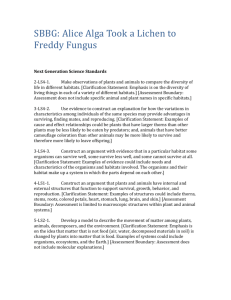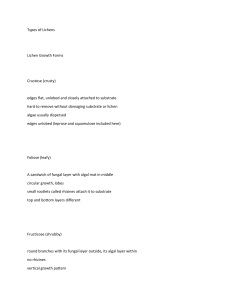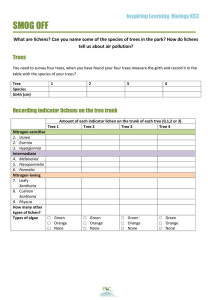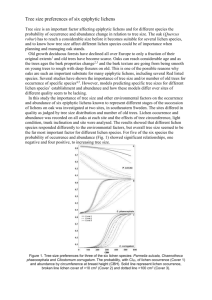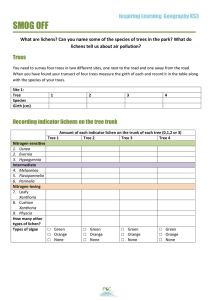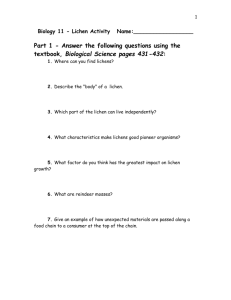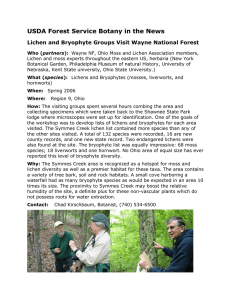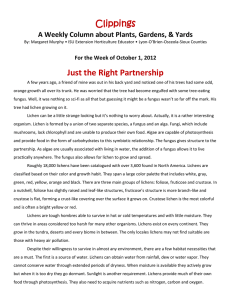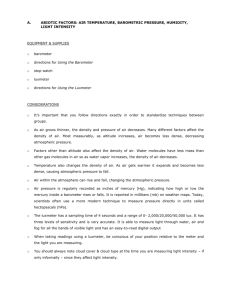Lichen Crust on Rocks & Boulders
advertisement
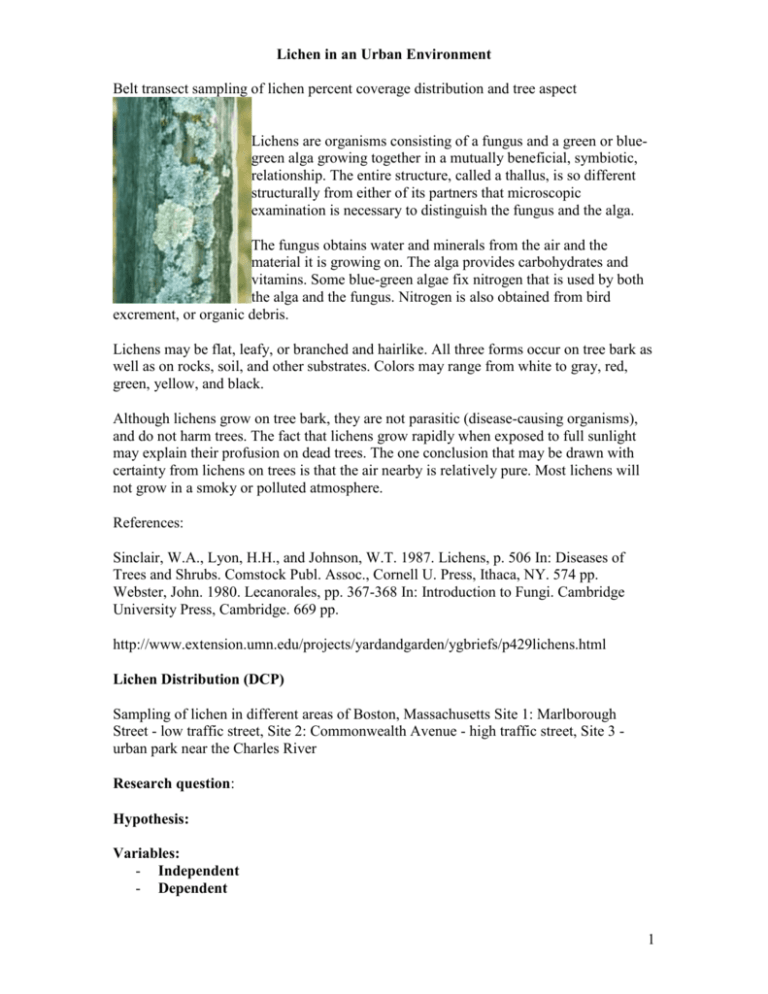
Lichen in an Urban Environment Belt transect sampling of lichen percent coverage distribution and tree aspect Lichens are organisms consisting of a fungus and a green or bluegreen alga growing together in a mutually beneficial, symbiotic, relationship. The entire structure, called a thallus, is so different structurally from either of its partners that microscopic examination is necessary to distinguish the fungus and the alga. The fungus obtains water and minerals from the air and the material it is growing on. The alga provides carbohydrates and vitamins. Some blue-green algae fix nitrogen that is used by both the alga and the fungus. Nitrogen is also obtained from bird excrement, or organic debris. Lichens may be flat, leafy, or branched and hairlike. All three forms occur on tree bark as well as on rocks, soil, and other substrates. Colors may range from white to gray, red, green, yellow, and black. Although lichens grow on tree bark, they are not parasitic (disease-causing organisms), and do not harm trees. The fact that lichens grow rapidly when exposed to full sunlight may explain their profusion on dead trees. The one conclusion that may be drawn with certainty from lichens on trees is that the air nearby is relatively pure. Most lichens will not grow in a smoky or polluted atmosphere. References: Sinclair, W.A., Lyon, H.H., and Johnson, W.T. 1987. Lichens, p. 506 In: Diseases of Trees and Shrubs. Comstock Publ. Assoc., Cornell U. Press, Ithaca, NY. 574 pp. Webster, John. 1980. Lecanorales, pp. 367-368 In: Introduction to Fungi. Cambridge University Press, Cambridge. 669 pp. http://www.extension.umn.edu/projects/yardandgarden/ygbriefs/p429lichens.html Lichen Distribution (DCP) Sampling of lichen in different areas of Boston, Massachusetts Site 1: Marlborough Street - low traffic street, Site 2: Commonwealth Avenue - high traffic street, Site 3 urban park near the Charles River Research question: Hypothesis: Variables: - Independent - Dependent 1 - Control Materials: 20cm x 20 cm clear grid Meter stick String GPS device tape Procedure: 1. We will sample 3 trees from each environment. The trees should be similarly sized and at least 60 cm in circumference. They should have an inclination of less than 10 degrees and there should not be any obvious disease or decay on the tree. 2. Measure 1 meter from the ground up the trunk of the tree 3. Tape a marker to delineate your overall starting point 4. Place the clear grid (20cm by 20 cm) plot on the tree and mark the number of squares where lichen is present with a dry erase marker (combine fractions of squares to arrive at whole number of 2 cm by 2 cm squares 5. Record the number of squares in your notebook 6. Repeat moving up the trunk of the tree towards the top of the tree for a total of 5 plots, recording the number of squares where lichen is present each time 7. Repeat steps 1 to 5 for all four cardinal directions. These are 1. north, 2. east, 3. south, 4.west. Use your GPS to determine the direction. 8. Share your data with the class 9. Process and present your data. You should consider abundance of lichen and need to figure out how to process the raw data to address your research question. This work is individual and cannot be done in teams. I should not see any data tables or graphs that look identical. 10. Lab will be assessed with the IB Criteria DCP and DEC (include a procedure that indicates what you actually did – do not copy this list) Data Collection: Data Processing: Discussion: Conclusion: Evaluation: 2
